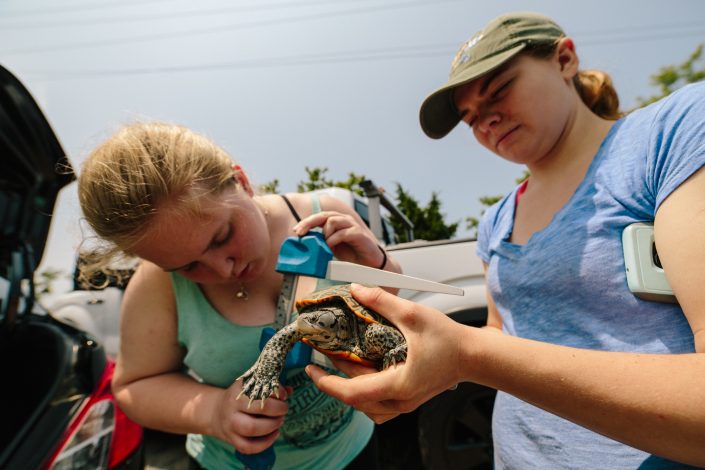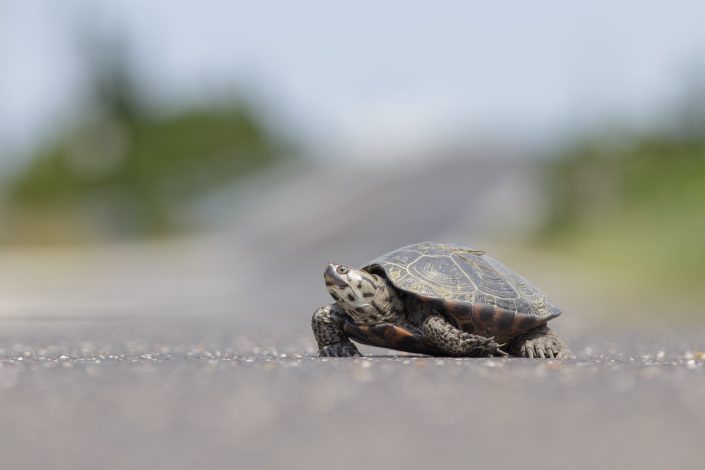Reducing Roadkills of Terrapins in S. Ocean County
Dedicated volunteers help reduce mortality of adult female terrapins
by Ben Wurst, Habitat Program Manager

Now that Northern diamondback terrapins (Malaclemys terrapin terrapin) are officially considered a nongame species, our work to help conserve breeding adult females is more justifiable. Before July 2016, adult terrapins, including egg bearing females, could be harvested during an open season from November to March. With that said, it was troublesome to know that a 15+ year old female that you helped safely cross a road in summer, could be harvested, shipped to Asia and eaten only a few months later… Now, we can rest (somewhat) easy knowing that the hard work of our dedicated volunteers will live on and help the population grow (there are still many threats to terrapins including collisions with boats, vehicles, poaching, drowning in ghost crab pots, etc…)
 Since 2010, we’ve worked to document roadkill hotspots for terrapins and to ensure that more adult female live on to complete their annual life cycle. Our main project area continues to be Great Bay Blvd., which is located inside Great Bay Blvd. WMA in Little Egg Harbor, NJ. As you will see in the graphic to the right, we’ve observed close to 5,000 individuals over the span of seven years. The main purpose of the Great Bay Terrapin Project is to reduce the amount of road kills of adult female terrapins in the Barnegat Bay, Great Bay, and Absecon Bay Watersheds (Ocean and Atlantic Counties). Each summer Conserve Wildlife Foundation of NJ recruits volunteers (Wildlife Conservation Corps) to assist with seasonal road patrols in June and July to document the occurrence of terrapins on roads and to help ensure their safe travel across roads. Lastly, we also work to raise awareness for terrapins by ensuring the installation of X-ING signs on roads with high use by terrapins.
Since 2010, we’ve worked to document roadkill hotspots for terrapins and to ensure that more adult female live on to complete their annual life cycle. Our main project area continues to be Great Bay Blvd., which is located inside Great Bay Blvd. WMA in Little Egg Harbor, NJ. As you will see in the graphic to the right, we’ve observed close to 5,000 individuals over the span of seven years. The main purpose of the Great Bay Terrapin Project is to reduce the amount of road kills of adult female terrapins in the Barnegat Bay, Great Bay, and Absecon Bay Watersheds (Ocean and Atlantic Counties). Each summer Conserve Wildlife Foundation of NJ recruits volunteers (Wildlife Conservation Corps) to assist with seasonal road patrols in June and July to document the occurrence of terrapins on roads and to help ensure their safe travel across roads. Lastly, we also work to raise awareness for terrapins by ensuring the installation of X-ING signs on roads with high use by terrapins.
In 2016 we began a mark-recapture study to help determine the overall size of the local population. Like our WCC volunteers, our research interns also conduct surveys on Great Bay Boulevard, but when they encounter a terrapin they collect morphometric data. They record the time, location, animal condition (live, injured, or dead); take measurements/weight, and then mark (by notching the marginal scutes) the individual before releasing it back into the wild.

From June 3 to July 18, we collected a total of 1082 terrapin sightings. Of those, a total of 132 were found dead on a roadway for an average road mortality rate of 12.2% throughout the entire survey area. On Great Bay Blvd. morphological data was collected from a total of 212 terrapins and 203 were notched by our research interns. Our dedicated volunteers patrolled for more than 400 hours and traveled over 3,500 miles. A total of 732 northern diamondback terrapins on Great Bay Boulevard and another 350 on other roads. A total 24 were found dead, which keeps the road mortality at half the rate (3% in 2017) observed during a study conducted in 2004-05. On Cedar Run Dock Road, two local residents patrol their road and record sightings of terrapins on the road and in their yard. This year they recorded a total of 245 with 4 being dead on the road (down from 307-live and 6-dead in 2016). We are actively working to source funding from the USFWS Partners Program to enhance nesting habitat for terrapins that utilize their backyard. Last but not least, we surveyed Route 30 four times in 2017, from June 12 to July 11. There we recorded a total of 95 road kills. Given the design of the road and speed limit, the mortality rate of adult female terrapins who enter this roadway is almost 100%.

In conclusion, as we look forward to another year of working to reduce road kills of adult female terrapins, we hope to broaden our focus to addressing the need for enhancing suitable habitat to help lure female terrapins away from busy roadways, like Route 30. We are thankful for all of the support and guidance that we receive from our partners, volunteers, and donors who support this project.
- Read the full report
- Learn more about our Great Bay Terrapin Project
- Donate to support this project!
In other news, we are currently accepting applications for our 2018 Terrapin Project Research Internship. Learn more and apply now!
Discover more from Conserve Wildlife Foundation of NJ
Subscribe to get the latest posts sent to your email.